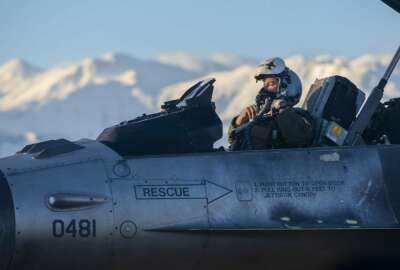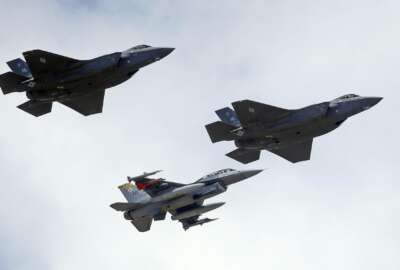 Exclusive
Exclusive Airline meeting is the beginning of a long road for Air Force on pilot shortage
The Air Force is meeting with airline companies May 18th, but the service isn't expecting to solve the pilot shortage quickly.
The Air Force’s meeting with airline companies about the service’s pilot shortage won’t end in any definitive actions.
That’s what Air Force Chief of Staff Gen. David Goldfein told Federal News Radio this week. The meeting, which is currently slated for May 18, will be more of a discussion between the two institutions vying for a small pool of experienced pilots.
“I don’t expect this to be a decision meeting. I’m looking at this as more of the beginning at my level of a real dialogue with [the airlines] to understand pressures they are under,” Goldfein said.
The Air Force is short more than 600 pilots and that deficit is growing. Air Force pilots are moving to major airlines after serving 10 years in the force. The airlines are offering airmen wages up to $200,000 to fill their large demand for pilots.
Goldfein said the need for pilots will soon reach international levels.
“I need 1,200 [pilots] a year, [the airlines] need 4,500 a year, for ten years. They exhaust my supply pretty quick and they exhaust our supply pretty quick, so the next place they are going to go is international,” Goldfein said. “We really have to look at this holistically to say ‘What are the nation’s needs for a pilot force to do commercial business, private and military aviation?’ and then ‘How do we look at new creative ways of plusing up the supply.”
Goldfein said he wanted to talk to the airlines about “making the right thing easier.” The right thing, he said, involves the Air Force retaining talent while still letting the airlines use quality pilots.
That might involve making the transition between guard, reserve and active duty easier for pilots so they can work for airlines part of the year and then move to being a full time Air Force pilot when needed, Goldfein said.
“More than anything I want to squint with my ears and listen to the CEOs and say ‘All right talk to me, tell me what you’re facing.’ This is not actually a competition in a competitive environment in terms of our discussion. This is about how do we team to do the nation’s business, which is to meet the requirement. I want the best pilots in the front of those airline [planes] because my kids fly on those airlines … but I absolutely need to retain that precious talent that we have in the military as well,” Goldfein said.
Congress seems to be on board with Goldfein. The House Armed Services Personnel Subcommittee held a hearing on the pilot shortage last week.
House Armed Services Committee Chairman Mac Thornberry (R-Texas) said part of the problem is budgeting.
“I can’t pass a law that creates pilots … The pressure on [the military] is to put more people through the pilot pipeline and when you are doing that with 30 year old airplanes et cetera, et cetera, you tend to have more problems,” Thornberry said after an April 5 hearing. “It’s money and time to fix these problems.”
Thornberry said he’s talked to the military about creating programs that could bring pilots who have left the service back in laterally for a short time to help with the shortage.
“The committee is very open if they need more authority from us,” Thornberry said.
The military is currently using reenlistment bonuses to try to keep pilots in the service, but their appeal is waning.
The Navy saw a 3.7 percent drop in new retention bonus contracts in 2015, dropping from almost 59 percent to 55 percent, stated a 2016 report to Congress.
The Air Force is seeing even bigger declines. In 2013, 68 percent of eligible pilots signed on for incentive pay contracts with the Air Force. That number dropped to 59 percent in 2014 and further to 55 percent in 2015. Only 410 out of 745 pilots eligible for bonuses actually took them in 2015. Only 42 percent of pilots offered early bonus contracts took the bait.
That’s especially troubling when the Air Force estimates that the cost to train one F-22 fighter pilot, for example, is $12.5 million.
One reason for the pilots’ lack of interest in bonuses is the size of the incentive pay. Pilots are allowed a maximum $25,000 bonus per year, a number that has not changed since 1999.
“We have no trouble recruiting pilots. We have more people who want to be pilots than we have spaces to train them. For us the issue is … we are not retaining enough,” Lt. Gen. Gina Grosso, the Air Force deputy chief of staff for Manpower, Personnel and Services, told Federal News Radio.
Grosso added that as pilots reach their 11th year in the service the Air Force needs to keep around 65 percent. Over the years, that number has slowly declined.
“We have gaps in the force and we are very, very concerned about this and our chief has called this a crisis,” Grosso said.
Grosso told Congress the new blended retirement system may provide less of an incentive for pilots to stay in the service for a full 20 years as well.
Part of the Air Force’s attempt to become more appealing to pilots involves bettering their quality of life.
Copyright © 2024 Federal News Network. All rights reserved. This website is not intended for users located within the European Economic Area.
Scott Maucione is a defense reporter for Federal News Network and reports on human capital, workforce and the Defense Department at-large.
Follow @smaucioneWFED




